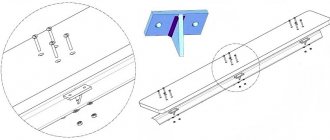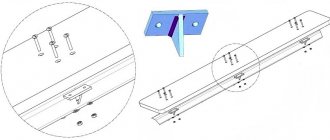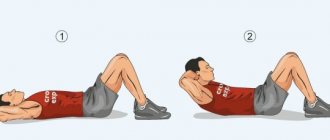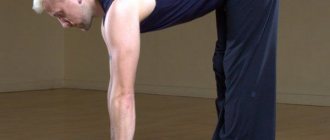The GTO norms for the abs, which involve lifting the torso from a supine position, is an exercise that is familiar to us from school. Both men and women undergo this test. Basically, this element is used as an elective test, starting at age 13.
The GTO standards for the press differ for each Stage, which you can see from the table below (unit of measurement is the number of times in 1 minute).
| — bronze badge | - silver badge | - gold badge |
| Stage (age) | Girls | Boys | ||||
| 1st stage (6-8 years) | 18 | 21 | 30 | 21 | 24 | 35 |
| Level 2 (9-10 years) | 24 | 27 | 36 | 27 | 32 | 42 |
| Level 3 (11-12 years old) | 28 | 30 | 40 | 32 | 36 | 46 |
| Level 4 (13-15 years old) | 31 | 34 | 43 | 35 | 39 | 49 |
| Level 5 (16-17 years old) | 33 | 36 | 44 | 36 | 40 | 50 |
| Stage (age) | Women | Men | ||||
| Level 6 (18-24 years old) | 32 | 35 | 43 | 33 | 37 | 48 |
| Level 6 (25-29 years old) | 24 | 29 | 37 | 30 | 35 | 45 |
| 7th stage (30-34 years old) | 19 | 22 | 33 | 26 | 31 | 41 |
| 7th stage (35-39 years old) | 17 | 20 | 29 | 24 | 29 | 39 |
| 8th stage (40-44 years old) | 14 | 16 | 25 | 22 | 27 | 35 |
| 8th stage (45-49 years old) | 10 | 12 | 21 | 19 | 24 | 31 |
| 9th stage (50-54 years old) | 8 | 11 | 18 | 14 | 19 | 27 |
| 9th stage (55-59 years old) | 7 | 9 | 15 | 11 | 15 | 24 |
| 10th stage (60-64 years old) | 5 | 7 | 13 | 9 | 12 | 21 |
| 10th stage (65-69 years old) | 4 | 6 | 11 | 6 | 9 | 16 |
| 11th stage (from 70 years old) | 2 | 4 | 8 | 4 | 6 | 14 |
Please also pay attention to the GTO standards for push-ups.
GTO norms for the abs: lifting the torso from a supine position
The GTO norms for the abs, which involve lifting the torso from a supine position, is an exercise that is familiar to us from school. Both men and women undergo this test. Basically, this element is used as an elective test, starting at age 13.
The GTO standards for the press differ for each Stage, which you can see from the table below (unit of measurement is the number of times in 1 minute).
| — bronze badge | - silver badge | - gold badge |
| Stage (age) | Girls | Boys | ||||
| 1st stage (6-8 years) | 18 | 21 | 30 | 21 | 24 | 35 |
| Level 2 (9-10 years) | 24 | 27 | 36 | 27 | 32 | 42 |
| Level 3 (11-12 years old) | 28 | 30 | 40 | 32 | 36 | 46 |
| Level 4 (13-15 years old) | 31 | 34 | 43 | 35 | 39 | 49 |
| Level 5 (16-17 years old) | 33 | 36 | 44 | 36 | 40 | 50 |
| Stage (age) | Women | Men | ||||
| Level 6 (18-24 years old) | 32 | 35 | 43 | 33 | 37 | 48 |
| Level 6 (25-29 years old) | 24 | 29 | 37 | 30 | 35 | 45 |
| 7th stage (30-34 years old) | 19 | 22 | 33 | 26 | 31 | 41 |
| 7th stage (35-39 years old) | 17 | 20 | 29 | 24 | 29 | 39 |
| 8th stage (40-44 years old) | 14 | 16 | 25 | 22 | 27 | 35 |
| 8th stage (45-49 years old) | 10 | 12 | 21 | 19 | 24 | 31 |
| 9th stage (50-54 years old) | 8 | 11 | 18 | 14 | 19 | 27 |
| 9th stage (55-59 years old) | 7 | 9 | 15 | 11 | 15 | 24 |
| 10th stage (60-64 years old) | 5 | 7 | 13 | 9 | 12 | 21 |
| 10th stage (65-69 years old) | 4 | 6 | 11 | 6 | 9 | 16 |
| 11th stage (from 70 years old) | 2 | 4 | 8 | 4 | 6 | 14 |
Please also pay attention to the GTO standards for push-ups.
Pump up your abs 25 times - can you do that?
- Now I looked at the standards for physical education. For a grade of 5 for grade 3, the norm is to understand the torso (pump up the abs, as I understand it) 25 times per minute. And do 12 pull-ups while lying down. I’m not talking about jumping rope 90 times in a minute (3 times in 2 seconds). Can you adults do this? It just became interesting.
- I’ll definitely do abs and jump rope, I’ve never been able to do pull-ups. The eldest daughter jumps 150 times in a minute on one leg (8th grade), the youngest (4th grade) meets the standard on a skipping rope, the abs are also easy for both of them, only the eldest can do pull-ups, but not 12 times, of course.
- They do it in physical exercises in the simplest way, lying on the floor, a partner holds your legs, hands behind your head and lifts your upper body. You can’t do this at school and after school only if you have a serious illness.
- Of course I can) My daughter can do 3 times faster) At school I wasn’t particularly athletic, but I passed all the standards with an A+. I really can’t do pull-ups... My first-grader daughter can do pull-ups normally, but not as required for this standard.
- Lying hanging pull-ups are very easy. I’ll never really do a pull-up either. And she did what was required of girls at school without any problems.
- I'll probably do a press. And I’ll catch up too. I probably won’t be able to do it with a jump rope at this pace.
- I looked at the results of the 2006-2007 girls' general physical fitness competition - this is not even 3rd grade))), at a ski school, the group is not yet sports, amateur, classes 2 times a week for 1.5 hours. Sports are not athletics, they don’t push physical fitness too much. Press - from 20 (the worst result) to 24 in 30 seconds!!, those 25 times in a minute are quite realistic)
- Easily))) And I, and even more so, a child. My preschooler will do this. You need to do physical exercise!
- Yes, it’s easy, I think the kids can do it too. And our eldest really knows how to pull herself up. And I love it in graviton
- Um... And what about the last one?
- abs - yes, I didn’t understand about hanging while lying down. I can’t do it with a jump rope anymore, but it was easy when I was a child.
- Not now. It's easy in 3rd grade
- It’s the other way around: I can, the child can’t.
- Hanging lying down
- So children are different, I said to myself in that context. As a child, everything was easy and I was surprised at those who had difficulty doing it.
- I can hardly handle a jump rope. I haven’t jumped for 25 years. And the rest is easy
- Of course not. And I never could. I am an extremely unsportsmanlike person. There was a special group in physical education at school.
- Certainly can. There is nothing like this for an adult. I don’t know for 3rd grade.
- Unfortunately, I can’t lift my abs more than 20 times. This is if we are talking about full body lifts without fixing the legs. And I couldn’t do it as a child. Jump rope now 100 times per minute. I do pull-ups for girls (these are the ones lying down) 50 times, if not for a while.
- Can. Both me and my daughter. My 5 year old son can’t do it yet. We are working on it
- I can. My son (a fifth grader) won’t be able to. I’ll add. For a full rise of the body, lying down with straight legs, the head of the inventor of the standards would have been torn off - if that’s what it is
- The press is easy, getting up is unlikely, jumping rope 90 times is easy, I’m not sure, though, at a pace of 1.5 jumps/sec.
- Can. I don’t know if she could do all this in the 3rd grade. For comparison, from the age of 5, my youngest daughter can do abs 30 times, do push-ups 30 times, do pull-ups on a bar (not while lying down, but normally) 2-3 times. Lying on your back, keep your legs raised at an angle of 45 degrees to the floor - 3 minutes (I - 45 seconds). The eldest daughter is not a particularly athletic girl, in physical education she gets not only straight A's, but also letters of gratitude and commendable entries in her diary. From which I conclude that there is nothing complicated in school physics.
- I can. My son (4th grade) can only press. He doesn’t know how to jump rope at all ((I’m not sure about hanging
- there was no press, I didn’t understand about pull-ups at all. The jump rope was and is, but not for a while - the speed of rotation of the rope depends on the number of jumps and there are 3 jumps in 2 seconds or even faster
- My son (2nd grade) can do all this thanks to the sports section. About myself - I don’t know, I haven’t tried. Recently at school a child passed a jump rope: in 20 seconds he had to do 5 30 times, the majority passed 5
- It’s unlikely that I’ll be able to pull myself up even this way; I’m also weak with a jump rope. But at school I did everything normally, it’s unlikely that the standards were lower then, rather the opposite.)))
- I can do it, I work out a couple of times a week in the gym, I do all this. And my daughter can do more; she’s been swimming for 8 years. He can do push-ups from the floor 25 times (after 15 I’m already squirming), he can lift his torso 50 times for sure, we didn’t measure further. Pull up a dozen times on the horizontal bar. But I don’t know about skipping rope, they are not trained with skipping rope, just all sorts of jumping and running. Therefore, maybe I wouldn’t give up the jump rope. But I hope they will forgive you for everything else...
- about the abs - for me the norm is only because my son goes to karate and does 90 times in three approaches there, and does just as many push-ups. but about the jump rope - it’s tough! And in general, for children who are not physically prepared... meh... I never liked all this at school) I just loved acrobatics) I’m all about the child) About myself - no! I don’t like sports)) I’m such an asshole, so it will be hard, although I like to jump rope and I like to swim.
- could. I remember and did more, physical teachers were always counting my indicators, then, in principle, children counted each other
- Press easily. Although I’m 40+ and, alas, I’m not at all athletic and have a lot of extra kilos... I haven’t tried doing pull-ups and jumping rope for a long time. I used to be able to... But I haven’t been doing anything sports for a long time. Occasionally I try to remember about exercises, that’s when I do a few exercises while lying down, including press 30 times.
- About the press 50 times in a minute or more, you bent it. Recently, at a competition at a sports school, we had the maximum 45 times, done by a 12-year-old boy. That's almost 2 times per second.
- Once per second. There are 60 of them in a minute
- Oh, that's right, I got it mixed up! We had it in 30 seconds! Then 50 times is quite realistic. Once a boy did 45 in 30 seconds.
- No problem. It amazes me that some adults (healthy and not elderly, of course) and even more so children cannot do this.(
- The press is easy, I’ve never tried lying down hanging pull-ups, I can’t handle a jump rope - I don’t know how to do it at all. My daughter won’t be able to do that much, that’s for sure. Will do less.
- Since the top has been created, you would have laid out the full 3rd class standards so that you don’t have to go to Yandex for the rest. And THANK YOU for the topic, mine can’t even come close, in general I was sure that the standards would only be there after the beginning. Now we will actively train in the summer.
- I brought my son up to 150 abdominal exercises at a continuous pace (not in a minute, of course) in about a couple of weeks of training. You just need to know how to make them. The main thing is to rush, quickly. When I showed him how to make them, I made about 40 of them myself, but then my stomach hurt terribly. I’m over 40, I haven’t been involved in sports in any form for 20 years. Sedentary lifestyle, excess weight. I also jumped rope as part of my child’s training, but the weight takes its toll. In childhood, these standards were easy to achieve.
- I can do it, although I haven’t been involved in sports for a very long time, my 8-year-old daughter does push-ups on the floor about 70 times a minute, touching her chest to a small cube on the floor, and pumps her abs about 50 times. He goes in for alpine skiing, but he rarely has physical fitness, once a week in September-October and that’s it...
- Where did you look at the standards? Need it too.
- but it’s not right to pump up your abs like that! And for genetically weak backs it is fraught! And since the school is not a sports school, but a regular school, then such standards and such a method are an ugliness!
- and in vain, in the sense of a continuous pace, it’s just endurance, stress for the body, with a minimum of benefits. Find on the same page how to properly pump up your abs with benefit.
- Yeah, it’s better not to download at all, otherwise genetics will be harmful.
- I don’t see anything outrageous in these numbers. Especially for children. It's much easier for them than for adults. At the age of 40, I can definitely do a jump rope and abs, but I can’t say about pull-ups, there’s nowhere to try. The child is not yet 7, she jumped at competitions 45 times in half a minute, the six-pack abs are actually pulled up in the usual way, not from a lying position, up to 20 times per approach.
- I think these are normal requirements
- But try it yourself, in fact, that’s what it turns out to be. and even faster. Jumping slower 3 times in 2 seconds can make you fall asleep. Yes, and pump your abs on the count
- mine is 10 years old, 4th grade) not very athletic (thin, really) - but she can easily pump her abs 25 times, her teacher even praised her. And jumping rope is generally her strong point
- The above is correct. Full lifting of the body with straight legs is unphysiological and dangerous for spinal injuries. It's really better than this
- Easily
- >The main thing is to jerk, quickly>And finish in the lower back.
- everything is fine, I don’t see a problem.
- hmm... I can. daughter 12 years old rocks 50
- I try at least 3 times a week at the gym, so I know I can’t do this
- I still can. In physical education at school I had a weak 3, which turned into a 2, but they gave me a 4 because all other grades in subjects were 5. Only I always passed the press 25 times a minute for a 5
- You can do the snatch only during the exam, probably. For practical purposes, the slower you are, holding the 45 degree position, the better the result.
- There's nothing to do with this in the lower back at all. And the abs hurt at first, but then they get used to it. And the goal was not to pump up the abs, but to pass the standards. As a child, I regularly passed them well this way.
- It was written above that the standard is 30 times per minute. That is, he is on speed. I didn't invent it. But he still trains his abs. Although there are upper and lower abs, external and deep. This only trains certain muscles.
- there the legs are not fixed, they move back and forth. If the legs are fixed both in the knees and in the ability to move back and forth, the exercise becomes hellishly difficult. And in the version “legs are straight, but move back and forth” - the exercise is not at all difficult, and there are no injuries
- Of course, 25 lifts in a minute is nothing at all, honestly. Any physically healthy child of 9-10 years old who is not involved in sports professionally can do it. While hanging, lying down, stretching - there’s nothing to do. Jumping rope 90 times means (for me) a child who doesn’t know how to jump at all and isn’t familiar with jumping rope. The standards are primitive, there is no need to be afraid of them. The eldest, a second-grader, is not an athlete at all, but he has some concept: abs - 32 times, jump rope - 99, hanging pull-ups - 15. And this is weak, very weak. Junior, 6.5 (training from Sports and Youth Sports School): press - 41, jump rope - 125, pull-up - 39. And without hanging, classic, 15 per minute. Me: jump rope - 200, press -55, hanging pull-up - 40. This relates to the question of whether adults can
- I can, but according to the standards for 7th grade, I can’t. I wonder how we can jump slower? Then the rope will get tangled. Jumping faster is easier.
- In general, I’ll do it at least a hundred times, we’re talking about the standard for a while.
- Do not worry. Mine is also not an athletic girl at all. I learned to bike, skate, ski, swim, thank God, I’m happy. And a B in physical education is not the most important thing in life. Although I am an athlete in life, and at first I was offended that the child was not athletic.
- I can, of course, because I play sports every day. My son can’t do it just by jumping rope - he’s a fourth grader.
- The fixation of the legs does not play a role in this case. This exercise can only be performed with the body raised to the level of the shoulder blades. A full lift, and even with unfixed legs - hello to the spine, because this can only be done slowly and smoothly, carefully twisting the body while lifting, which is impossible in units per minute
- how they are not fixed, they used to push them under the bench and now I also saw that they are fixed, done in pairs, well, what I saw at our school in the yard.
- I don’t know how now, when I was in school, the first time they took a physical education exam in the final grades, where they also had to pass this abs. So, when you hold your legs, it is much easier to do, but this was prohibited, you had to hold them yourself in a motionless position.
- Moreover, you need to play sports so that such questions do not arise. I saw 11th graders here - only a few ran 3 km. Sorry sight!
- Easily. What's so outrageous about it?
- My daughter, for whom I looked up the standards, has been playing badminton for four years, and still dances with the appropriate loads; in the summer, on a hike with a backpack, she can easily cover 5 or more kilometers - not enough? At the same time, he can’t jump at such a speed, and it’s also difficult to pump up the abs. I don’t understand why the hell we should need this.
- Yes, I’m not worried, I was just wondering what they evaluate there
- Well, a girl really needs abs, a jump rope develops coordination, agility, it’s also a cardio exercise... Everything is needed - both with a backpack and jumping.
- Badminton jumping is through the roof. What is the point of jumping rope exactly this many times per minute? What is indispensable about doing abs in a minute? Everything is needed - you said it correctly. There's enough of everything. Why exactly are the standards needed, those that are required in the stake? Me and my family don’t need them. We need a normal healthy active lifestyle, which is already present.
- I’m very happy for you that you will do it at least a hundred times) the question was: will adults be able to pump their abs 25 times a minute, etc., I answered that I can... About my daughter, I also wrote about standards for time (number of times PER MINUTE) What do you need I do not like???
- Not in a minute (without time), but we do gymnastics 20 times. Children are 5-6 years old. And then do the back 20 times. They generally do everything without time. He can also jump with a skipping rope 20 times without stopping, but he usually gets lost more than that. But in total, maybe 90 times. Last year I myself reached just 25 times)))) on a special bench you lie upside down at an angle. I had very weak abs, after the c-section there was no way I could restore them, and that was very good for me. I wouldn’t have jumped that much with a jump rope. I can’t do pull-ups. Daughter too for now
- Uh, why? Doesn’t badminton imply the usual general physical training? Press, jump rope = this is general physical training - almost any sports training begins and ends with it... Standard training - 2-2.5 hours - this is half an hour of general physical training - warm-up, at the end - 15 minutes - cool-down - and what is between them is the sport itself... I thought it was like this everywhere)
- I can’t and I couldn’t do it at school. I hate physical training with all my heart, it’s a stupid pastime. I'd rather read it.
- On the contrary, it’s easier to do it under the bench. Because they are of course fixed there vertically (but not tightly), but not fixed horizontally. The legs are moving there. And when you need to get up, you cling to this bench with your feet and the body is attracted to the bench, that is, it rises. In order to easily do the exercise, you need to somehow overcome a very small part of the body’s path, the initial rise from a lying position, literally a few centimeters. It’s at this moment that you cling to the support with your feet and rise up. And then it is very, very important to have mobility of the legs in the horizontal plane. When you rise, your legs should move forward. When you lie down, they move back again and cling to a support (holding a child or a bench). That’s when a child, due to inexperience, presses his friend’s legs tightly, for example, sitting on the lap of another - then there’s a pitchfork, yes. But since, as a rule, the legs are held with the hands, there is enough mobility for the exercise. I probably explained it stupidly, but it’s very difficult to put it into words. And if no one holds, then at the moment the heels begin to lift, they come off the floor a little. The knees are straight, but the heels go down a little and the desired angle is obtained, and then it’s like on a swing: the legs return to the floor, lifting the body.
- 30, but not 150
How to learn how to pump up your abs correctly?
Pumped up abs, first of all, are the result of proper exercises. A trainer or teacher can develop and select a set of exercises for this muscle group. You can also watch video lessons or books on physical education. These exercises will help to form correct posture (very important for schoolchildren) and maintain the spine and its flexibility so that it is in good shape until our old age.
The GTO standards for abs for girls 13-17 years old are around 30-40 times per minute. It is interesting to emphasize that, with minor changes, such indicators are considered the norm up to 40 years.
Basic recommendations: how to learn how to pump your abs correctly
We wish you to always be in great shape!
How to improve the result in the “Abs” exercise when meeting the GTO standards?
To successfully comply with GTO standards, it is necessary to perform all tests of the complex to “gold”. If your abs are your weak point, we will help you fix it!
Raising the body is a classic abdominal exercise, known to everyone since school physical education lessons.
Lifting the body to the corner is a more complicated version of the exercise. It combines static and dynamic loads on the abdominal muscles and is suitable for those who have worked on their abs for at least 1-2 weeks.
Lifting your legs alternately also pumps up your lateral abdominal muscles.
The plank is a powerful static exercise in which the athlete focuses on the forearms and toes while maintaining natural lordosis in the lower back.
Excellent for working the rectus abdominis muscle, the plank should be done for the maximum amount of time until you are able to maintain the correct body position.
How to do abs 50 times in 1 minute
Sculpted abs are the dream of many men and women, but how can you make your dream come true? Famous sports bloggers say: “Abs are made in the kitchen.” This means that not only training, but proper nutrition will create six-pack abs, because nutrition should be given more importance than pumping up muscles. We’ll find out further how to properly pump up your abs without leaving home.
Is it possible to pump up your abs at home without going to the gym?
Indeed, to see the cubes, you need to get rid of the fat layer and this is not so easy. You can perform a training complex for years, but still not see sculpted abs, but you can achieve good results in a month. Sweets, flour products and many other simple carbohydrates will cover the abdominal muscles with a layer of fat, and no matter how hard you train your abs, there will be no effect.
When training at home, you need to start by introducing proper and healthy foods into your regimen. Moreover, each product must be taken on time, without leading the body to starvation and without slowing down the metabolism.
Fortunately, you don't need any special machines or equipment to train. Classes can be done using your own weight. All you need is a mat; you can add, if desired, special weighted cuffs to increase the load and pump up your abs.
Since the body can get used to each load, it is necessary to use additional weights or the help of a partner to complicate the exercise. At home, you can use your imagination by taking bottles of water in your hands instead of dumbbells, and this will be very effective. Therefore, it is quite possible to do an abdominal workout at home without spending much time. But remember, the rest of the time is spent monitoring nutrition.
What does it take to see abs on your stomach?
In order to quickly pump up perfect abs, you must first of all get rid of excess fat. Abdominal muscles do not require enormous effort to improve the tone and shape of the cubes; they are already anatomically formed so that they can be viewed provided there is a complete absence of subcutaneous fat. Accordingly, the smaller the adipose tissue, the more prominent the cubes on the abdomen.
You can lose fat through exercise, but it should not be limited to abdominal exercises. To speed up the results, you need to perform cardio training, which stimulates overall fat burning, then fat will be lost evenly from the entire body. Training should be regular, but you shouldn’t do it every day.
The abdominal muscles recover quite quickly, so you can load them within a day. Abdominal exercises can be performed after cardio exercise. For example, after a 30-minute run, a complex for the press is performed. Another important condition for drawing cubes is the correct diet. Nutrition should not slow down the results. By fulfilling all the requirements, each week the cubes will be visible more clearly.
Are there any differences between women's ab workouts and men's?
The muscle structure of men and women is the same. Therefore, there is no difference in training for this group. Men have more strength, and more often than not, they want to have hard and voluminous abdominal muscles. This may be where the difference between training of different genders may appear.
A man can take a heavier weight and perform a set of 10–12 repetitions. A girl can also train, but she may not have enough strength for such training, but the essence is the same - abdominal training for men and women can be done the same. For some the results will be faster, for others it will take longer. For both, to burn fat in the abdominal area, you need to perform the exercise a large number of repetitions.
Preparation for compliance with the GTO standard
STRENGTH, SPEED, ENDURANCE, FLEXIBILITY, AGILITY
TRAINING PROGRAM FOR MEETING GTO STANDARDS IS SUITABLE FOR REGULAR SPORTS AT HOME AND OUTDOORS
WHAT IS GTO (READY FOR WORK AND DEFENSE) GTO is a special set of tests (tests) to determine the level of physical fitness.
The complex includes various exercises (mandatory and optional), exams differ for men and women, and the GTO standards are divided into 11 levels depending on age.
Each age has its own specific requirements for the level of physical fitness. The GTO complex was invented and developed back in the USSR in 1931, and now it is a sports
the movement is being actively revived with new standards and exercises.
As in Olympic sports, the GTO has a bronze badge, a silver badge and a gold badge.
Certain standards have been developed for each level; anyone can pass the GTO standards and receive an official insignia (like a medal in sports) and a certificate.
Of course, in order to successfully pass the tests, you need to have a sufficient level of development of physical qualities. For this I have developed special training programs,
which allow you to prepare for passing the standards for bronze, silver and gold.
WHAT IS A TRAINING PROGRAM FOR PASSING GTO STANDARDS This is a training program that is aimed at the diversified development of an athlete.
The program includes exercises to develop strength, speed, endurance and flexibility. Of course, special preparation is required for the exercises that must be performed to receive the TRP insignia.
Training programs differ for men and women plus are divided by
age levels in accordance with GTO standards.
This complex of physical training can be used not only for performing GTO, but also for regular sports training.
Excellent for adjusting weight, developing strength, flexibility and endurance, for forming a sports figure with developed sculpted muscles. You receive a sports training manual with detailed instructions.
Everything is included - just train regularly and complete the task as planned. Training does not require a large amount of special equipment, so
train wherever it is convenient for you – at home, on the street, or in the gym for physical education.
PROGRAM GOALS 1. Special step-by-step physical training for passing GTO standards up to the gold mark 2. General physical training (general physical training) - development of strength, endurance, speed and flexibility
3. Fitness training, building an athletic physique without excess fat
Please note that the program is aimed specifically at developing physical capabilities. To pass the GTO standards, it is necessary to pass various tests, and among them may be, for example, skiing, swimming or other sports elements. This program does not teach you swimming or skiing techniques, but you will become stronger, faster and more resilient, you will get an athletic body
and developed muscles that are ready to perform complex tasks.
WHO NEEDS A TRAINING PROGRAM 1. On the official website gto.ru, look at the standards for passing the TRP standards and determine whether you need a training program, or are you ready to pass all the tests. 2.
The GTO physical training program is an excellent training system that includes various types of exercises to train the muscles of the whole body.
Even if you are not going to take the GTO exams at all, this program can be used for training
- at home to be a physically developed, healthy person with an athletic figure.
- PREPARATION PROGRAMS FOR PASSING GTO STANDARDS FOR MEN 4 LEVEL GTO – SCHOOL CHILDREN 13-15 YEARS OLD – in development, send applications 5 LEVEL GTO – SCHOOL STUDENTS 16-17 YEARS OLD – in development, send applications
- 6 LEVEL GTO – MEN 18-29 YEARS OLD
- 9 LEVEL GTO – MEN 50-59 YEARS OLD – in development, send applications
- PREPARATION PROGRAMS FOR PASSING GTO STANDARDS FOR WOMEN 5 LEVEL GTO - SCHOOLGIRL 16-17 YEARS OLD - in development, send applications 6 LEVEL GTO - WOMEN 18-29 YEARS OLD - in development, send applications 7 LEVEL GTO - WOMEN 30-39 YEARS OLD - in development , send applications 8 LEVEL GTO – WOMEN 40-49 YEARS OLD – in development, send applications
- 9 LEVEL GTO – WOMEN 50-59 YEARS OLD – in development, send applications
- The training programs were developed by Physical Training Specialist, Master of Sports and author of the website AthleticBlog.ru
- Sergey Sivets
7 LEVEL GTO – MEN 30-39 YEARS OLD – in development, send applications 8 LEVEL GTO – MEN 40-49 YEARS OLD – under development, send applications
Anatomy of abdominal muscles
The group we are interested in, the one that forms the sculpted abs, is called the rectus abdominis muscle. It starts from the sternum, the anterior surface of the costal cartilages and passes downwards, attaching to the pubic bone. It is interrupted by tendon bridges, which form the abs. The muscle allows you to twist your back in the lumbar region.
The fibers of the external oblique muscle begin from the lateral surface of the chest, passing into the wide aponeurosis. Its fibers are located along an oblique line, passing from top to bottom in the direction of the external intercostal muscles. Its function is to rotate the chest in the opposite direction relative to the pelvis, as well as flex the spine during bilateral contraction.
Also, under the listed external muscles, there are deep ones: the transverse abdominal muscle and the internal oblique. They are stabilizers of the spine, fixing the stable and correct position of the lumbar region and pelvis.
How to remove excess fat and quickly pump up your abs?
Proper nutrition for cubes
The first thing you need to pay attention to is the contents of your daily diet and, in no case, ignore the importance of eating behavior. You can quickly tighten your stomach only by following a competent diet and choosing the right diet.
Start simple, remove all excess, namely:
Instead, look for foods that are low on the glycemic index, low in calories, and low in fat and carbohydrates.
To draw cubes you need to use more:
Nutrition before and after training
Training should begin no less than an hour and a half after eating. If you train in the afternoon or evening, with an emphasis on strength training, then it is permissible to eat complex carbohydrates along with protein, since the carbohydrates will be absorbed immediately. But don't overeat. If you exercise in the morning or afternoon, then consuming carbohydrates at lunch, after your workout, will be your last carbohydrate intake. The rest of the time you can consume proteins and vegetables. The main way to lose weight is to cut carbohydrates.
Menu example 1
Menu example 2
You can also include a multivitamin complex and fish oil, more precisely polyunsaturated omega-3 fatty acids, in your diet. They will help burn belly fat, breaking it down to be used as an energy source during workouts.
The best abdominal exercises at home
When performing the exercise, try to include in the work exactly the area that you want to work. The neuromuscular connection plays an extremely important role when pumping up any muscle group. This will allow the necessary fibers to be included in the work as much as possible and make the movement more efficient.
Crunches
Various crunches are the most effective way to work the abdominal muscles, which contract directly when twisting the body.
Important! Do the exercises correctly! Raising the body should be performed only with a rounded back, lowering to the floor in turn with each part of the spine. And lower crunches (leg raises) on a bench or on the floor are performed only with the lower back tightly pressed to the floor, without bending. Both techniques will eliminate the possibility of injury to the lumbar spine.
However, exercises by themselves are ineffective if you do not perform fat-burning complexes and cardio exercises.
This is an excellent and affordable way to combat excess fat. This type of cardio burns subcutaneous fat as energy necessary for work. By reducing waist size, running can gradually create a beautiful contour. But in addition to fat burning, it is necessary to tone the muscles, then the appearance of the abs will be more distinct and harmonious. The look of such a waist will be more sporty.
Circuit training
Another one of the most effective ways to form beautiful abs is circular fat-burning training. Their essence is to work out all muscle groups in a short time. Exercises should be performed without pause and involve as many muscles and joints as possible in one exercise. You can exercise with your own weight, without special equipment. Three lessons per week is enough. Naturally, the complex also includes abdominal exercises, which helps to quickly achieve results, both overall weight loss and muscle toning. Cardio exercises along with strength training are the most effective method of getting a beautiful belly.
A set of exercises for drying the press
From the anatomical structure it is clear that the rectus muscle is located along the entire length of the front of the body from the chest to the groin; it is a solid muscle that is divided by membranous tendons. When twisting, lifting, folding, the abdominal muscles work completely, and not its individual parts. The concept of the top and bottom of the press exists more as a measure of sensation in a certain area in a particular exercise. Muscle contractions are more noticeable in either the lower or upper part, depending on the exercise. But remember, in any case, the muscle is fully worked.
Upper abs exercises
Curling your torso on the floor
Lying on the floor, feet up, legs slightly bent at the knees. Hands behind your head, chin looking up, not pressing against your collarbones. As you exhale, the upper part of the body is folded, lifting only the shoulder blades, the lower back is pressed tightly to the floor. As we inhale, we return to lying on our shoulder blades. The exercise is performed dynamically, without pauses or breath holdings. Perform 20–30 times, 3–4 approaches.
Rolling up the torso with the lower leg on a bench
The shins are placed on the bench, forming a right angle at the knees. Lying with your back on the floor, press your lower back tightly to the floor. With your palms behind your head, as you exhale, we roll up the thoracic region, feeling a burning sensation in the upper part of the rectus muscle. The chin is not pressed against the collarbones, the gaze is directed to the ceiling. Exhale and lower your shoulder blades to the floor. Perform at a dynamic pace 20–30 times, 3–4 approaches.
Lower abs exercises
Lower crunches
Lying on the floor, palms under the buttocks. The lower back is pressed tightly to the floor. Legs together, raised perpendicular to the floor. As you inhale, lower your feet down without bending your lower back. Exhale – lower the abdomen and raise the legs up. Repeat 20–30 times, 3–4 approaches.
Short pelvic thrusts
Lying on the floor, legs together, raised perpendicular to the floor. Using quick and short movements with the lower part of the rectus muscle, we push the pelvis upward. By tearing off only the sacral section, the lower back remains on the floor. Perform 30–40 times, 3–4 approaches.
Exercises for obliques
Side crunches
Lying on the floor, right foot on the floor, bending the left knee, place the foot on the right knee. The right hand is behind the head, and the left is extended to the side, performing an emphasis. As we exhale, we twist diagonally, straining the oblique muscles, and with the elbow of our right hand we aim for the opposite knee. The lower back does not lift off the floor, only lifting the scapula; the chin does not fall toward the sternum. Perform 20 – 30 times.
How to take the press test for the GTO?
There is nothing complicated about how to pass your abs for the GTO badge. The main thing is to train strength and endurance.
Initial position:
- lie on your back on a rug or gymnastics mat;
- your legs are bent at the knees at a right angle, the assistant presses your feet to the floor;
- hands behind the head, fingers clasped in a “lock”;
- the shoulder blades reach the mat.
Your task is to perform the maximum number of lifts in exactly 1 minute, with your elbows touching your hips (knees), and then returning back to the starting position.
Only correctly performed body lifts will be credited to you, that is, there should not be the following errors:
- there was no contact of elbows with knees or hips
- the shoulder blades did not touch the mat
- fingers opened
- the pelvis has shifted.
By
The best set of exercises for sculpted six-pack abs
This workout consists of seven carefully selected ab exercises to train at home, equally good for working both the upper and lower parts of the abdomen.
Like most people, you can train your abdominal muscles long and hard. But if you need to show six-pack abdominal muscles with a large percentage of subcutaneous fat, then you can’t do without a proper diet with a calorie deficit. If your goal is sculpted abs, you can’t do without proper training.
This training complex includes seven selected exercises to work the upper and lower abdominal muscles. Do it three times a week and, combined with proper nutrition, strength training and optimal cardio training, your abs will transform in no time.
3 circuits, minimal rest between exercises and 1-2 minute break between circuits
How to do this set of abdominal exercises
This is a workout for advanced athletes, so how you perform it plays a vital role.
For beginners, it is better to take no more than three exercises out of seven, doing two sets of each with a maximum number of repetitions and a minute pause between sets. Next, increase the duration of your workouts by adding exercises and sets and reducing rest time.
Your ultimate goal is, at the end of 12 weeks, to be able to complete all seven exercises in one long circuit without resting, rest for 1-2 minutes, and repeat twice more.
While you can’t do this yet, you can break the workout into parts as you wish. For example, I like to do the following supersets:
Each superset continues until short-term muscle failure occurs, or until repetitions begin to be difficult.
You may have noticed that the routine does not directly engage the obliques. This is explained by the fact that in my experience, purposefully working these muscles only makes the waist wider. In addition, the oblique muscles are perfectly loaded during squats, deadlifts and other basic exercises with your own body weight.
How many repetitions are recommended?
To work out the abs, experienced trainers and bodybuilders advise working in the range of 20-30 repetitions per approach, but everything is not so simple. It's not so much the repetitions that matter, but the duration of the load.
You should try to perform each set for 40-50 seconds, and how many repetitions of the press you will have time to do depends on the complexity of the exercise: crunches can be performed up to 30 times or more, and when lifting legs while hanging on the bar, you can have time to perform 10-12 technical repetitions. In both cases, the abdominal muscles will receive the same load.
It is not recommended to work in one approach for more than a minute, otherwise the muscles will become acidified due to the release of lactic acid. This slows down the recovery process and interferes with muscle growth. Try to choose such exercises and work in such a mode as to achieve a burning sensation.
Video
Optimal number of approaches
It’s clear with repetitions, but how many sets of abdominal exercises should you do? Here, for beginners and experienced bodybuilders, the answer is the same - from 3 to 4 approaches for each exercise. The number of exercises in a complex can be different: beginner athletes only need one, while professional athletes may need two or three or even more.
Another topic plays an important role: how much rest do you need between abdominal exercises? The break should not be too long so that the muscles do not have time to cool down. Try to work intensively, resting no more than 40-60 seconds between sets.
How long to train?
The number of weekly ab workouts also plays a role for both beginners and experienced athletes. On average, it is recommended to conduct two abdominal training sessions per week, working to failure each time. For beginners, you can limit yourself to one workout per week so that the abdominal muscles, which are not ready for new loads, have time to recover.
Gradually, your abs will become stronger, and you will be able to train them twice a week with the same effectiveness. When you gain experience, listen to your body. If your abs are still sore after your previous ab workout, you shouldn’t do a new workout.
There is often erroneous information on the Internet that you need to train your abs daily to achieve quick results.
Coaches and experienced athletes do not recommend repeating this mistake, otherwise you will overtrain and your results will stagnate.
Of course, at first the abdominal muscles will pump up a little, but it is impossible to develop them indefinitely in this mode. So, limit yourself to one or two workouts per week.
When to train your abs
For most people, doing this routine at least three times a week will be enough. Advanced bodybuilders can do it every day.
Personally, I like to do abs and cardio first thing in the morning when I get out of bed, leaving strength training for the afternoon. This is how I speed up my metabolism as much as twice a day.
If you prefer to train everything in one fell swoop, I would recommend loading the abs as a warm-up before strength training or a cool-down after it if you are planning on heavy exercises like squats or deadlifts. And after that, go to cardio.
How to do the exercises
Exercise 1: Sit-up
Target muscles: Upper abs
Exercise 2: Leg Raises
Target muscles: Lower abs
Exercise 3: Fold Sit-ups
Target muscles: Upper and lower abs
Exercise 4: Pulling your knees to your chest
Target muscles: Lower abs
Exercise 5: Toe Touch
Target muscles: Upper and lower abs
Exercise 6: Crunches
Target muscles: Upper abs
Exercise 7: Reverse crunches
Target muscles: Upper and lower abs
How to speed up results
Features of the press
The abdominal press is created by the muscles located on the walls of the abdomen. It performs a number of important functions for the body. The abdominals include the internal obliques and external rectus muscles, which create a kind of frame that supports the entire body.
The internal muscles and external obliques are located perpendicular to one another, and the rectus muscles are vertical.
An effectively selected set of exercises will pump up each of them, making them attractive in appearance.
For classes you need to have:
- Chair or sofa;
- 20 minutes of free time;
- Powerful motivation;
- Positive attitude.
Exercise 1
You need to sit on the edge of a chair or sofa. Legs are raised above the floor surface.
- The position is quite uncomfortable, the muscles are very tense, it is necessary to maintain balance.
- In order to somehow maintain balance, it is recommended to support your back with your hands, with emphasis on the sofa.
- Next, bend the legs towards the body, and then slowly straighten them, bend them again and slowly straighten them - and so on 20 times.
- The exercise can be supplemented with cross leg swings.
Exercise 2
To perform this you will need to lay a sports mat on the floor. The person performing the exercise lies on the floor, raises his legs together at a right angle, and then lowers them.
- Perform the described movements for 20 times.
- For beginners, you can reduce the amount to avoid severe pain.
- The exercise is also effective because it pumps not only the abdominal muscles, but also the leg muscles, as a result of which they acquire beautiful outlines.
Important: It is quite difficult to lift your legs symmetrically in a lying position. Therefore, it is advisable to support the buttocks with your hands.
Exercise 3
In a lying position, you need to make rotational movements with your legs, imitating riding a bicycle. Twenty times - in one direction and the same amount - in the opposite direction. Then you can rest a little, relax your muscles.
Exercise 4
The exercise is also performed in a lying position. The performer bends his legs and points them towards the chest. Then slowly moves his legs back to the starting position. The exercise is performed 20 times.
Exercise 5
To perform the next sports exercise, the performer lies with his back on the floor and places his legs on a chair or sofa.
- Slowly begin to twist the torso, trying to raise the shoulder blades.
- In this version of the sports activity, you can avoid touching your knees with your hands.
- The described exercise will be useful for people with spinal problems.
Exercise 6
The exercise is more difficult. Starting position: back on the floor, legs on the sofa. The main task is to reach your elbows to your knees, while keeping your hands behind your head. This exercise helps pump up the abs and also twist the torso. The exercise is done 20 times.
Note: If a person experiences pain when doing crunches on a hard floor, you are allowed to lie on the sofa with your feet on a soft armrest.
Exercise 7
Great exercise for losing weight. The starting position is as in exercise 6. Only now you need to reach your heels with your hands, not your elbows, crossing your hands behind your feet. The exercise must be done at least 20 times.
Exercise 8
You need to lunge with your left leg and bend forward with your arm, as if picking up a fallen object from the floor. The exercise is repeated 3-4 times. Place your hands at the back of your head and turn your upper body to the right side. Then the leg is changed and exercises are performed for 30 seconds on one side.











